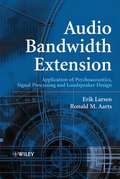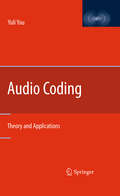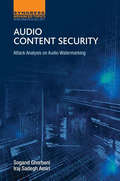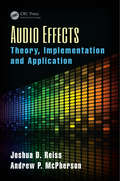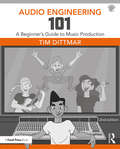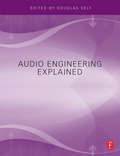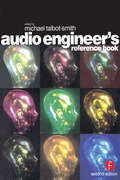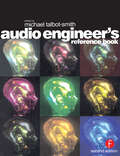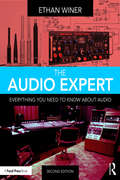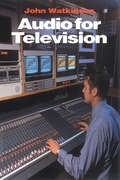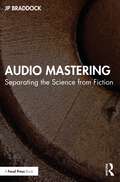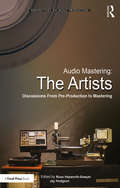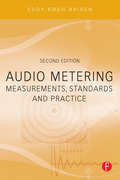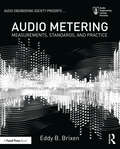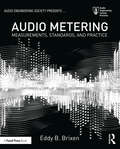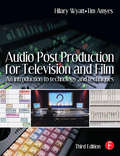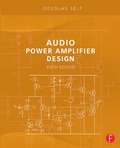- Table View
- List View
Audio Bandwidth Extension: Application of Psychoacoustics, Signal Processing and Loudspeaker Design
by Erik Larsen Ronald M. AartsBandwidth extension (BWE) refers to various methods that increase either the perceived or real frequency spectrum (bandwidth) of audio signals. Such frequency extension is desirable if at some point the frequency content of the audio signal has been reduced, as can happen for example during recording, transmission or reproduction. This volume, significant in dealing exclusively with BWE, discusses applications to music and speech and places particular emphasis on signal processing techniques. Presents an all-encompassing approach to BWE by covering theory, applications and algorithms Reviews important concepts in psychoacoustics, signal processing and loudspeaker theory Develops the theory and implementation of BWE applied to low-frequency sound reproduction, perceptually coded audio, speech and noise abatement Includes a BWE patent overview Audio Bandwidth Extension pulls together recent developments in to a single volume and presents a coherent framework to the reader. Such an approach will have instant appeal to engineers, specialists, researchers and postgraduate students in the fields of audio, signal processing and speech.
Audio Coding: Theory and Applications
by Yuli YouAudio Coding: Theory and Applications provides succinct coverage of audio coding technologies that are widely used in modern audio coding standards. Delivered from the perspective of an engineer, this book articulates how signal processing is used in the context of audio coding. It presents a detailed treatment of contemporary audio coding technologies and then uses the DRA audio coding standard as a practical example to illustrate how numerous technologies are integrated into a fully-fledged audio coding algorithm. Drawing upon years of practical experience and using numerous examples and illustrations Dr. Yuli You, gives a description of practical audio coding technologies including: • Designing high-performance algorithms that can be readily implemented on fixed-point or integer microprocessors. • How to properly implement an audio decoder on various microprocessors. Transient detection and adaptation of time-frequency resolution of subband filters. • Psychoacoustic models and optimal bit allocation. Audio Coding: Theory and Applications will be a valuable reference book for engineers in the consumer electronics industry, as well as students and researchers in electrical engineering.
Audio Content Security: Attack Analysis on Audio Watermarking
by Iraj Sadegh Amiri Sogand GhorbaniAudio Content Security: Attack Analysis on Audio Watermarking describes research using a common audio watermarking method for four different genres of music, also providing the results of many test attacks to determine the robustness of the watermarking in the face of those attacks. The results of this study can be used for further studies and to establish the need to have a particular way of audio watermarking for each particular group of songs, each with different characteristics. An additional aspect of this study tests and analyzes two parameters of audio host file and watermark on a specific evaluation method (PSNR) for audio watermarking.Describes research using a common audio watermarking method for four different genres of musicProvides the results of many test attacksPresents tests and analyzes two parameters of audio host file and watermark on a specific evaluation method (PSNR) for audio watermarking
Audio Effects: Theory, Implementation and Application
by Joshua D. ReissAudio Effects: Theory, Implementation and Application explores digital audio effects relevant to audio signal processing and music informatics. It supplies fundamental background information on digital signal processing, focusing on audio-specific aspects that constitute the building block on which audio effects are developed. The text integrates t
Audio Engineering 101: A Beginner's Guide to Music Production
by Tim DittmarPratical, concise, and approachable, Audio Engineering 101, Second Edition covers everything aspiring audio engineers need to know to make it in the recording industry, from the characteristics of sound to microphones, analog versus digital recording, EQ/compression, mixing, mastering, and career skills. Filled with hand-on, step-by-step technique breakdowns and all-new interviews with active professionals, this updated edition includes instruction in using digital consoles, iPads for mixing, audio apps, plug-ins, home studios, and audio for podcasts. An extensive companion website features fifteen new video tutorials, audio clips, equipment lists, quizzes, and student exercises.
Audio Engineering 101: A Beginner's Guide to Music Production
by Tim DittmarPratical, concise, and approachable, Audio Engineering 101, Second Edition covers everything aspiring audio engineers need to know to make it in the recording industry, from the characteristics of sound to microphones, analog versus digital recording, EQ/compression, mixing, mastering, and career skills. Filled with hand-on, step-by-step technique breakdowns and all-new interviews with active professionals, this updated edition includes instruction in using digital consoles, iPads for mixing, audio apps, plug-ins, home studios, and audio for podcasts. An extensive companion website features fifteen new video tutorials, audio clips, equipment lists, quizzes, and student exercises.
Audio Engineering Explained
by Douglas SelfAll the design and development inspiration and direction an audio engineer needs in one blockbuster book! Douglas Self has selected the very best sound engineering design material from the Focal and Newnes portfolio and complied it into this volume. The result is a book covering the gamut of sound engineering.The material has been selected for its timelessness as well as for its relevance to contemporary sound engineering issues.
Audio Engineering Explained
by Douglas SelfAll the design and development inspiration and direction an audio engineer needs in one blockbuster book! Douglas Self has selected the very best sound engineering design material from the Focal and Newnes portfolio and complied it into this volume. The result is a book covering the gamut of sound engineering.The material has been selected for its timelessness as well as for its relevance to contemporary sound engineering issues.
Audio Engineer's Reference Book
by Michael Talbot-SmithAn authoritative reference on all aspects of audio engineering and technology including basic mathematics and formulae, acoustics and psychoacoustics, microphones, loudspeakers and studio installations. Compiled by an international team of experts, the second edition was updated to keep abreast of fast-moving areas such as digital audio and transmission technology. Much of the material has been revised, updated and expanded to cover the very latest techniques. This is a new paperback version.
Audio Engineer's Reference Book
by Michael Talbot-SmithAn authoritative reference on all aspects of audio engineering and technology including basic mathematics and formulae, acoustics and psychoacoustics, microphones, loudspeakers and studio installations. Compiled by an international team of experts, the second edition was updated to keep abreast of fast-moving areas such as digital audio and transmission technology. Much of the material has been revised, updated and expanded to cover the very latest techniques. This is a new paperback version.
The Audio Expert: Everything You Need to Know About Audio
by Ethan WinerThe Audio Expert is a comprehensive reference book covering all aspects of audio, with both practical and theoretical explanations. It is written for people who want to understand audio at the deepest, most technical level, but without needing an engineering degree. The Audio Expert explains how audio really works in much more depth than usual, using common sense plain-English explanations and mechanical analogies, with minimal math. It uses an easy to read conversational tone, and includes more than 400 figures and photos to augment the printed text. However, this book goes beyond merely explaining how audio works. It brings together the concepts of audio, aural perception, musical instrument physics, acoustics, and basic electronics, showing how they’re intimately related. It also describes in great detail many practices and techniques used by recording and mixing engineers, including video production and computers. This book is meant for intermediate to advanced recording engineers and audiophiles who want to become experts. There’s plenty for beginners too. One unique feature is explaining how audio devices such as equalizers, compressors, and A/D converters work internally, and how they’re spec’d and tested, rather than merely describing how to use them. There’s plenty of myth-busting and consumerism too. The book doesn’t tell readers what brand power amplifier to buy, but it explains in great detail what defines a good amplifier so people can choose a first-rate model wisely without over-paying. Most explanations throughout the book are platform-agnostic, applying equally to Windows and Mac computers, and to most software and hardware. Many audio and video examples are included to enhance the written text. The new edition offers many updates and improvements throughout. New sections on coding an equalizer, comparing microphone preamps, testing results of loudspeaker isolation devices, new online video content on music theory, plus incorporated chapters on MIDI basics, computers, video production, plus new myth-busters, and much more!
The Audio Expert: Everything You Need to Know About Audio
by Ethan WinerThe Audio Expert is a comprehensive reference book covering all aspects of audio, with both practical and theoretical explanations. It is written for people who want to understand audio at the deepest, most technical level, but without needing an engineering degree. The Audio Expert explains how audio really works in much more depth than usual, using common sense plain-English explanations and mechanical analogies, with minimal math. It uses an easy to read conversational tone, and includes more than 400 figures and photos to augment the printed text. However, this book goes beyond merely explaining how audio works. It brings together the concepts of audio, aural perception, musical instrument physics, acoustics, and basic electronics, showing how they’re intimately related. It also describes in great detail many practices and techniques used by recording and mixing engineers, including video production and computers. This book is meant for intermediate to advanced recording engineers and audiophiles who want to become experts. There’s plenty for beginners too. One unique feature is explaining how audio devices such as equalizers, compressors, and A/D converters work internally, and how they’re spec’d and tested, rather than merely describing how to use them. There’s plenty of myth-busting and consumerism too. The book doesn’t tell readers what brand power amplifier to buy, but it explains in great detail what defines a good amplifier so people can choose a first-rate model wisely without over-paying. Most explanations throughout the book are platform-agnostic, applying equally to Windows and Mac computers, and to most software and hardware. Many audio and video examples are included to enhance the written text. The new edition offers many updates and improvements throughout. New sections on coding an equalizer, comparing microphone preamps, testing results of loudspeaker isolation devices, new online video content on music theory, plus incorporated chapters on MIDI basics, computers, video production, plus new myth-busters, and much more!
Audio for Television
by John WatkinsonAudio for Television outlinines all the relevant principles and practices. Newcomers to the field will find it an invaluable, up to date resource and experienced sound people will gain from the explanations of new technology. The rate of change in the technology of television sound has recently accelerated to such a degree that it is now a sufficiently expansive subject to warrant a book of its own. These rapid changes, from the introduction first of stereo, then multi-channel or surround sound, have made it difficult for those working in this field to keep up with the technology and even harder for those just setting out on a career in television sound.The book considers analog and digital audio as alternatives and stresses the advantages of both. Microphone and loudspeaker technology is also discussed in some detail and audio recording and routing and transmission are also covered.
Audio for Television
by John WatkinsonAudio for Television outlinines all the relevant principles and practices. Newcomers to the field will find it an invaluable, up to date resource and experienced sound people will gain from the explanations of new technology. The rate of change in the technology of television sound has recently accelerated to such a degree that it is now a sufficiently expansive subject to warrant a book of its own. These rapid changes, from the introduction first of stereo, then multi-channel or surround sound, have made it difficult for those working in this field to keep up with the technology and even harder for those just setting out on a career in television sound.The book considers analog and digital audio as alternatives and stresses the advantages of both. Microphone and loudspeaker technology is also discussed in some detail and audio recording and routing and transmission are also covered.
Audio Mastering: Separating the Science from Fiction
by JP BraddockAudio Mastering: Separating the Science from Fiction is an ideal guide to tangible development as a mastering engineer. This book offers a comprehensive overview of mastering processes, teaching the reader to link critical listening skills with analysis to comprehend the processing required to improve the quality of their audio. Whether involved in game audio, composing for film and television, producing rock or programming EDM, the aesthetics required to manipulate and assess audio for mastering are a highly valuable addition to any artist or engineer's skill set. Audio Mastering encourages readers to engage in personal analysis and, in doing so, contextualise their evaluations by linking to appropriate and available processing tools. Discussion of processing conventions and theory are included to help readers create an effective audio chain utilising the best properties from each process, as well as practical examples and additional online resources to support development of skilled processing control. This is a thorough and practical textbook for audio engineers, artists, producers and students on music production, music technology and music performance courses, and for aspiring and developing mastering engineers.
Audio Mastering: Separating the Science from Fiction
by JP BraddockAudio Mastering: Separating the Science from Fiction is an ideal guide to tangible development as a mastering engineer. This book offers a comprehensive overview of mastering processes, teaching the reader to link critical listening skills with analysis to comprehend the processing required to improve the quality of their audio. Whether involved in game audio, composing for film and television, producing rock or programming EDM, the aesthetics required to manipulate and assess audio for mastering are a highly valuable addition to any artist or engineer's skill set. Audio Mastering encourages readers to engage in personal analysis and, in doing so, contextualise their evaluations by linking to appropriate and available processing tools. Discussion of processing conventions and theory are included to help readers create an effective audio chain utilising the best properties from each process, as well as practical examples and additional online resources to support development of skilled processing control. This is a thorough and practical textbook for audio engineers, artists, producers and students on music production, music technology and music performance courses, and for aspiring and developing mastering engineers.
Audio Mastering: Discussions from Pre-Production to Mastering (Perspectives on Music Production)
by Russ Hepworth-Sawyer Jay HodgsonAudio Mastering: The Artists collects more than twenty interviews, drawn from more than 60 hours of discussions, with many of the world’s leading mastering engineers. In these exclusive and often intimate interviews, engineers consider the audio mastering process as they, themselves, experience and shape it as the leading artists in their field. Each interview covers how engineers got started in the recording industry, what prompted them to pursue mastering, how they learned about the process, which tools and techniques they routinely use when they work, and a host of other particulars of their crafts. We also spoke with mix engineers, and craftsmen responsible for some of the more iconic mastering tools now on the market, to gain a broader perspective on their work. This book is the first to provide such a comprehensive overview of the audio mastering process told from the point-of-view of the artists who engage in it. In so doing, it pulls the curtain back on a crucial, but seldom heard from, agency in record production at large.
Audio Mastering: Discussions from Pre-Production to Mastering (Perspectives on Music Production)
by Russ Hepworth-Sawyer Jay HodgsonAudio Mastering: The Artists collects more than twenty interviews, drawn from more than 60 hours of discussions, with many of the world’s leading mastering engineers. In these exclusive and often intimate interviews, engineers consider the audio mastering process as they, themselves, experience and shape it as the leading artists in their field. Each interview covers how engineers got started in the recording industry, what prompted them to pursue mastering, how they learned about the process, which tools and techniques they routinely use when they work, and a host of other particulars of their crafts. We also spoke with mix engineers, and craftsmen responsible for some of the more iconic mastering tools now on the market, to gain a broader perspective on their work. This book is the first to provide such a comprehensive overview of the audio mastering process told from the point-of-view of the artists who engage in it. In so doing, it pulls the curtain back on a crucial, but seldom heard from, agency in record production at large.
Audio Metering: Measurements, Standards And Practice
by Eddy BrixenIn this comprehensive guide Eddy Bøgh Brixen will take you through the complex and confusing concept of audio metering, giving you the knowledge and skills you need to utilize optional signal levels and produce high quality audio. Covering all areas of this essential topic, Audio Metering begins with the basics- audio definitions and digital techniques, and works up to hearing and psychoacoustics. Levels in audio are defined, and the metering standards and practices are discussed, covering the existing standards abs VU and PPM, as well as the new loudness metering standards, making this the reference guide to audio metering. This new edition includes * Current information on loudness metering, covering existing and new standards, defining terms like LU, RLB, and LKFS* Explanations of music sounds and structures * An extended chapter on topics relevant to the sound engineer in the field of psychoacoustics* More details on speech intelligibility and it's measures* The skills needed for both small room acoustics and large auditoriums sound design without losing sound quality * An extended glossary Packed full of valuable information that can be applied to a wide variety of everyday tasks, this handbook is essential reading for all technicians and engineers working with acoustics, electro acoustics and audio forensics. It also provides essential information for anyone working with loudspeakers and large scale amplifiers, including sound design for theatrical and live audio set-ups.
Audio Metering
by Eddy BrixenIn this comprehensive guide Eddy Bøgh Brixen will take you through the complex and confusing concept of audio metering, giving you the knowledge and skills you need to utilize optional signal levels and produce high quality audio. Covering all areas of this essential topic, Audio Metering begins with the basics- audio definitions and digital techniques, and works up to hearing and psychoacoustics. Levels in audio are defined, and the metering standards and practices are discussed, covering the existing standards abs VU and PPM, as well as the new loudness metering standards, making this the reference guide to audio metering. This new edition includes * Current information on loudness metering, covering existing and new standards, defining terms like LU, RLB, and LKFS* Explanations of music sounds and structures * An extended chapter on topics relevant to the sound engineer in the field of psychoacoustics* More details on speech intelligibility and it's measures* The skills needed for both small room acoustics and large auditoriums sound design without losing sound quality * An extended glossary Packed full of valuable information that can be applied to a wide variety of everyday tasks, this handbook is essential reading for all technicians and engineers working with acoustics, electro acoustics and audio forensics. It also provides essential information for anyone working with loudspeakers and large scale amplifiers, including sound design for theatrical and live audio set-ups.
Audio Metering: Measurements, Standards and Practice (Audio Engineering Society Presents Ser.)
by Eddy BrixenIn this comprehensive guide, Brixen takes the reader through the complex and confusing aspects of audio metering, imparting the knowledge and skills needed to utilize optional signal levels and produce high-quality audio. Covering all aspects of this fundamental subject, Audio Metering: Measurements, Standards and Practice begins with the basics, such as audio definitions and digital techniques, and works up to more complex topics like hearing and psychoacoustics. This revised and expanded third edition includes: Updated information on loudness metering, covering both existing and new standards. Definitions of terms such as LKFS, LUFS, gating, LRA. Explanations of signal types and musical sounds and structures. Further details on immersive audio. Skills needed for both small-room acoustics and large auditorium sound design without loss of sound quality. Descriptions of measurement signals and systems for audio and acoustic sound. A chapter on listening tests from small set-ups to large-scale comparisons of PA/SR-systems. Packed full of valuable information with a wide range of practical applications, this is the essential reference guide to audio metering for technicians, engineers, and tonmeisters, as well as sound designers working with acoustics, electroacoustics, broadcast, studio recording, sound art, archiving, audio forensics, and theatrical and live-audio setups.
Audio Metering: Measurements, Standards and Practice (Audio Engineering Society Presents Ser.)
by Eddy BrixenIn this comprehensive guide, Brixen takes the reader through the complex and confusing aspects of audio metering, imparting the knowledge and skills needed to utilize optional signal levels and produce high-quality audio. Covering all aspects of this fundamental subject, Audio Metering: Measurements, Standards and Practice begins with the basics, such as audio definitions and digital techniques, and works up to more complex topics like hearing and psychoacoustics. This revised and expanded third edition includes: Updated information on loudness metering, covering both existing and new standards. Definitions of terms such as LKFS, LUFS, gating, LRA. Explanations of signal types and musical sounds and structures. Further details on immersive audio. Skills needed for both small-room acoustics and large auditorium sound design without loss of sound quality. Descriptions of measurement signals and systems for audio and acoustic sound. A chapter on listening tests from small set-ups to large-scale comparisons of PA/SR-systems. Packed full of valuable information with a wide range of practical applications, this is the essential reference guide to audio metering for technicians, engineers, and tonmeisters, as well as sound designers working with acoustics, electroacoustics, broadcast, studio recording, sound art, archiving, audio forensics, and theatrical and live-audio setups.
Audio Post Production for Television and Film: An introduction to technology and techniques
by Hilary Wyatt Tim AmyesPreviously titled Audio Post-production in Video and Film, this third edition has been completely revised and restructured to provide a step-by-step guide to the professional techniques used to shape a soundtrack through the production process. Covering sound for both film and television, this edition includes many of the practical techniques and shortcuts used by experienced editors and mixers. Part one explains the basics of audio post production - how audio is recorded, how sound and picture stay in sync, how audio can be exported from system to system, and how film and video technology works. Part two follows the path of production sound from its original recording right through to the final mix, and includes sections on editing sound with picture, dialogue, sound effects and music editing, how to run ADR and Foley record sessions, and mixing, using many practical examples.Audio Post Production for Television and Film is aimed at professionals already working in the industry, newcomers, students and those considering sound for film and television as a career - in fact anyone who wants an insight into current professional practices and a comprehensive overview of the sound post production process.
Audio Post Production for Television and Film: An introduction to technology and techniques
by Hilary Wyatt Tim AmyesPreviously titled Audio Post-production in Video and Film, this third edition has been completely revised and restructured to provide a step-by-step guide to the professional techniques used to shape a soundtrack through the production process. Covering sound for both film and television, this edition includes many of the practical techniques and shortcuts used by experienced editors and mixers. Part one explains the basics of audio post production - how audio is recorded, how sound and picture stay in sync, how audio can be exported from system to system, and how film and video technology works. Part two follows the path of production sound from its original recording right through to the final mix, and includes sections on editing sound with picture, dialogue, sound effects and music editing, how to run ADR and Foley record sessions, and mixing, using many practical examples.Audio Post Production for Television and Film is aimed at professionals already working in the industry, newcomers, students and those considering sound for film and television as a career - in fact anyone who wants an insight into current professional practices and a comprehensive overview of the sound post production process.
Audio Power Amplifier Design
by Douglas SelfThis book is essential for audio power amplifier designers and engineers for one simple reason...it enables you as a professional to develop reliable, high-performance circuits. The Author Douglas Self covers the major issues of distortion and linearity, power supplies, overload, DC-protection and reactive loading. He also tackles unusual forms of compensation and distortion produced by capacitors and fuses. This completely updated fifth edition includes four NEW chapters including one on The XD Principle, invented by the author, and used by Cambridge Audio. Crosstalk, power amplifier input systems, and microcontrollers in amplifiers are also now discussed in this fifth edition, making this book a must-have for audio power amplifier professionals and audiophiles.
